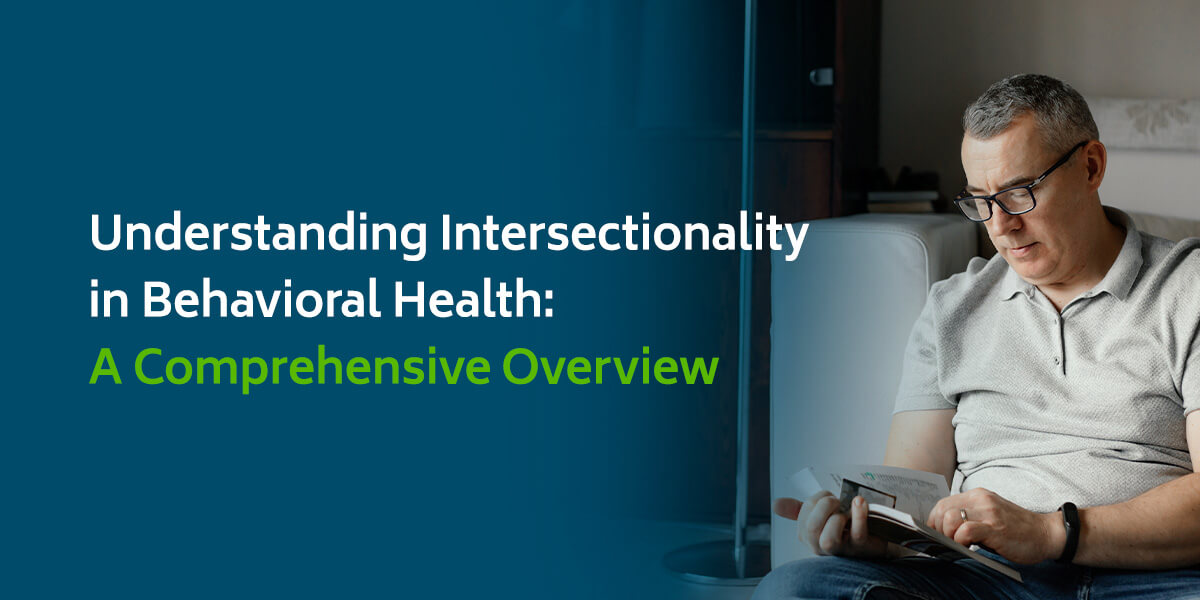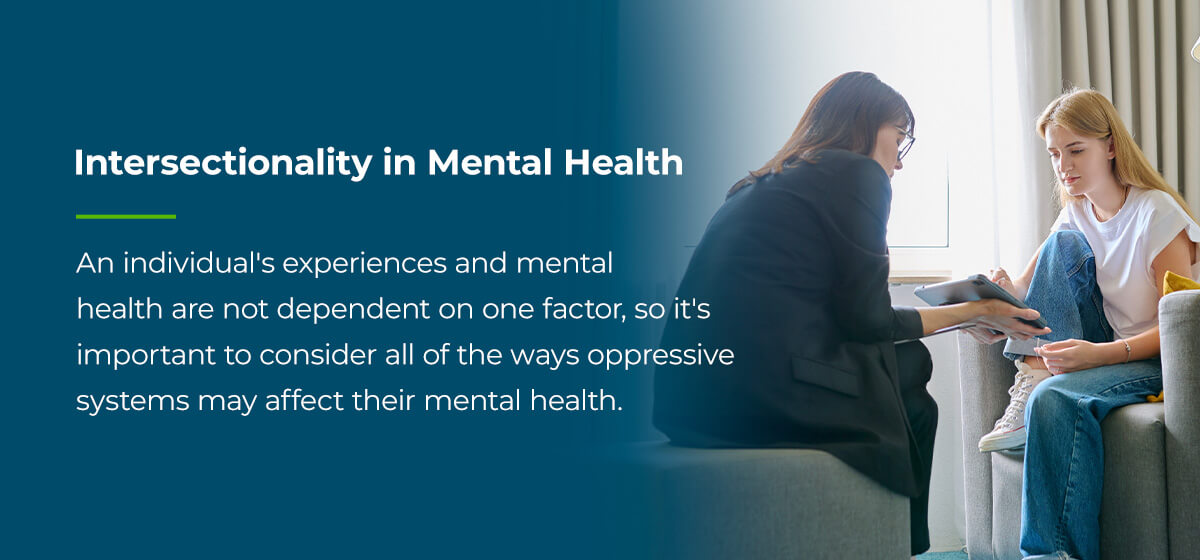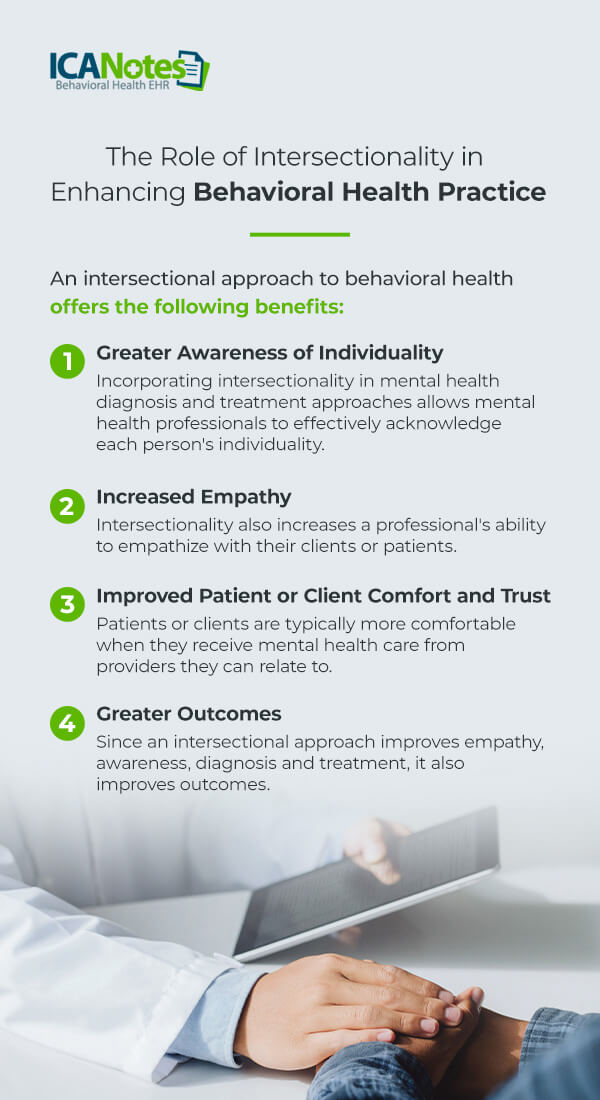
Understanding Intersectionality in Behavioral Health: A Comprehensive Overview
Intersectionality is an acknowledgment that individuals and groups who share an identity experience additional intragroup differences based on diverse identity markers. The goal of this framework is to better understand and eliminate the inequalities minority groups face. Understanding intersectionality and its impact on mental health can help your practice make mental health care more accessible and effective, helping people receive the treatment they need.
What Is Intersectionality?
Intersectionality is an analytical model to help individuals understand how various political and social identities cause diverse privilege and discrimination combinations. This framework models how social categorizations such as gender, race and class are interconnected. It's an acknowledgment that each group of people can share a common identity while also experiencing intragroup differences, advantages and disadvantages based on unique differences such as the following:
- Age
- Race
- Ethnicity
- Gender
- Location
- Spoken language
- Socioeconomic status
- Immigration or citizenship status
- Sexuality
- Religion and spirituality
- Family status
- Occupation and income
- Life experience
- Disabilities
- Income
- Caste
- Refugee status
- HIV status
- Housing situation
- Work history
Understanding Intersectionality: Core Concepts and Key Points
Consider the following core concepts and key points to better understand intersectionality:
Origin of Intersectionality
Kimberlé Crenshaw first coined the term ‘intersectionality’ in 1989. She used this term to express how a person's identity and how it differs from others' identities can determine their exposure to negative and positive experiences. Over time, people started to use it in everyday life, social media and academic groups.
Originally, the term described how oppressive systems overlap and cause individuals with multiple identity categories to have distinct experiences. For example, a woman of color may experience racism and sexism simultaneously rather than one or the other.
Definitions and Core Concepts of Intersectionality
The core concept of intersectionality is that interdependent discrimination systems overlap. Discrimination against an individual or group can have several layers or dimensions. Intersectionality focuses on addressing the further discrimination that occurs within discrimination and finding ways to protect minorities within larger minority groups.
For example, focusing exclusively on gender ignores how an individual may also face discrimination or lack opportunities due to age and ethnicity, and vice versa. Feminism focuses on gender oppression, but a Muslim woman facing gender oppression may also face discrimination due to her religion.
Consider the following six core concepts of intersectionality to understand this framework better:
- Intersecting power relations: Intersecting power relations are diverse systems and forces that mutually influence society. Systems such as classism, racism and sexism operate on structural and interpersonal levels to affect individuals’ experiences and identities.
- Social inequality: Social inequality is a significant term in intersectionality discussions because it refers to people having unequal opportunities and occupying different social hierarchical positions due to various systems and processes such as colonialism, capitalism, white supremacism, patriarchy and nationalism.
- Relationality: Relationality refers to how different power systems and social inequalities people previously treated as separate actually interact.
- Social context: The concept of social context emphasizes the importance of considering time and place when shaping an individual’s experiences.
- Social justice: Social justice is the main goal of intersectional work. It refers to increasing equity in distributing and accessing economic and social resources and opportunities. The goal is to achieve this through critical practice.
- Complexity: Complexity refers to the world’s complex nature and the complexity of the intersectional work process.
Goals of Intersectionality
To understand intersectionality work, consider the framework's following goals:
- Achieving social justice
- Ensuring communities and social justice movements are inclusive
- Encouraging diverse groups to respect individual differences and work together
- Ensuring each individual and group is part of the fight for equality and justice so no one is left behind
- Preventing groups from combating one discrimination form at the expense of others
Intersectionality in Mental Health
Intersectionality emphasizes the importance of approaching social problems while considering all the oppressive systems affecting people. Rather than focusing on one oppressive system for each social problem, it's essential to look at the full picture of the discrimination, social constructs and political systems affecting individuals and groups. This same approach is true in mental health.

An individual's experiences and mental health are not dependent on one factor, so it's important to consider all of the ways oppressive systems may affect their mental health. Additionally, a person's unique identity can influence how they cope with mental health.
Intersectionality and Mental Health Stigma and Oppression
Minoritized groups and individuals typically receive fewer mental health resources. They have limited access to mental health care, and the consequences of mental health conditions they experience are often longer lasting and more severe than other groups. Additionally, systematic racism creates the following barriers and obstacles preventing individuals from receiving help:
- Shame and stigma within communities
- Language and cultural differences between clients and providers
- Insufficient insurance coverage or lack of insurance
Individuals who identify with multiple marginalized groups may find it difficult to seek help. They typically encounter more biases within their communities, and they often face challenges finding clinicians who speak their language and understand their culture.
Intersectionality in Behavioral Health Practice
Intersectionality has a significant impact on behavioral health practice. It affects mental health as well as individuals' and groups' access to mental health care, ultimately impacting outcomes and the likelihood of people seeking treatment.
Addressing Intersectionality in Behavioral Health
Since minoritized individuals and groups face mental health care obstacles, behavioral health practices must take steps to bridge the gap. Consider the following ways your mental health practice can address intersectionality to help marginalized groups and individuals gain more care access:
- Invest in community outreach: Community outreach efforts such as free mental health screenings and advocacy events can help more marginalized individuals learn about their mental health care options.
- Create a plan to connect with clients effectively: Creating a diversity, equity and inclusion (DEI) plan can help your practice identify areas of strength and areas for improvement in patient or client care.
- Hire diverse staff: A diverse staff is crucial for bridging the gap between minoritized groups and mental health care. Having more psychiatrists, psychologists, counselors and therapists who speak diverse languages and thoroughly understand cultural differences can meet client needs.
- Practice cultural competence: While hiring diverse staff is important, you can also help staff members practice cultural competence, recognizing and respecting cultural backgrounds.
The Influence of Intersectionality on Mental Health Outcomes
Identity markers such as gender, age, race, ethnicity and socioeconomic status significantly impact mental health, but they are not the issue. The true problem is the power systems that maintain and amplify discrimination and oppression. The inequality, erasure, discrimination, violence, biases and lack of opportunities that marginalized individuals face immensely impact mental health outcomes.
Individuals with one or multiple identity markers may experience specific life stressors that others don't. For example, a female refugee may experience financial stress and safety concerns that individuals with citizenship status don't face. Similarly, individuals in the LGBTQ community may face social stressors that heterosexual individuals don't.
On community, national and global levels, advocating for equitable systems and fighting oppressive constructs is important for improving mental health outcomes. Individual practices can help improve outcomes for their patients and local communities by acknowledging the unique challenges oppressed individuals face and addressing them in treatment.
Intersectionality in Behavioral Health: A Critical Examination
Intersectionality is a crucial part of behavioral health services. Incorporating intersectionality in mental health practices has significant benefits and can help improve treatment outcomes.
Intersectionality and its Relevance in Behavioral Health Care
Intersectionality matters in mental health because it helps individuals receive the care and treatment they need. It transforms the mental health field by revealing areas for improvement, increasing awareness of patient needs and improving how providers approach treatment.
Intersectionality is a vital tool the mental health care sector can use to help eliminate the inequality and disadvantages marginalized groups experience. It provides insight into why inequalities exist so providers can take action to improve care. An intersectional approach helps prevent providers from dismissing individuals' unique experiences and cultural practices. It also helps prevent providers from mispronouncing names, misgendering individuals and providing inferior treatment.
Instant Webinar
Never Miss the Mark: How to Ensure Your Documentation is A+ 100% of the Time!
Access this informative webinar on how to effortlessly enhance your skills in maintaining comprehensive and top-notch documentation practices for your mental health notes.
What You'll Learn:
- Importance of Excellent Documentation
- The Golden Thread
- Considerations of Documentation
- Assessments
- Treatment Planning
- Progress Notes
The Role of Intersectionality in Enhancing Behavioral Health Practice
Understanding the importance of the intersectional framework on mental health can help you improve your practice, provide higher-quality treatment and positively impact your community. An intersectional approach to behavioral health offers the following benefits:

1. Greater Awareness of Individuality
Incorporating intersectionality in mental health diagnosis and treatment approaches allows mental health professionals to effectively acknowledge each person's individuality. A greater understanding of intersectionality helps mental health practitioners recognize their clients' or patients' needs. It prevents professionals from diagnosing people inaccurately and using standardized or ‘cookie-cutter’ treatments for every person.
2. Increased Empathy
Intersectionality also increases a professional's ability to empathize with their clients or patients. A healthy level of empathy is necessary for managing and responding to emotional experiences. Understanding an individual's unique identity markers helps a professional empathize with their feelings.
3. Improved Patient or Client Comfort and Trust
Patients or clients are typically more comfortable when they receive mental health care from providers they can relate to. The more comfortable an individual is, the more likely they are to be open and honest about their experiences and express their needs. Greater attention to intersectionality helps increase trust between an individual and their provider. An intersectional approach increases efforts to match individuals with mental health professionals they closely identify with who can offer the most effective help.
For example, a traditional approach may match a female Muslim client with a female therapist, but an intersectional approach may match the same client with a female therapist who also shares or understands her religion. A transgender individual may fear a therapist will label their identity as a mental health condition, but a therapist who accepts their transgender identity can make them feel comfortable during treatment.
4. Greater Outcomes
Since an intersectional approach improves empathy, awareness, diagnosis and treatment, it also improves outcomes. When a mental health practitioner acknowledges an individual's unique needs and challenges and empathizes with their emotions, they can offer the most effective treatment possible.
How Intersectionality Creates a Pathway to Better Treatment Outcomes
What works for one person may not work for another, so determining the right treatment, therapy and medication is essential for each patient or client. For example, someone who identifies in the LGBTQ community may need trauma-informed therapy if they feel unaccepted within their family or social circles.
A woman of color may feel more comfortable receiving therapy from a therapist who also identifies as a woman of color. Individuals with low incomes may need financial assistance to receive talk therapy. Understanding each person's needs and proactively finding ways to remove obstacles to their mental health care can significantly improve treatment outcomes.
The intersectionality framework also encourages providers to consider the impact of intergenerational trauma, enabling providers to help individuals work through it effectively. A provider who understands the importance of intergenerational trauma can help an individual heal from emotional wounds their ancestors may have passed down. For example, a therapist can effectively help an individual who identifies with an ethnic minority group and the LGBTQ community process their experiences related to both of these identity markers.
Incorporating Intersectionality in Behavioral Health Practices

You can implement an intersectional approach in your practice with the following tips:
- Prevent biases and stereotypes: Biases and stereotypes can impact a provider's thought processes and decision-making regarding patient care. It can also affect how a provider treats patients. Educating staff about biases and how to reframe thinking can help them treat each patient or client with respect, empathy and compassion. It also helps your practice make accurate diagnoses and determine the best treatment options.
- Discourage harmful language: While you should always prohibit discriminatory slurs, it's also important to discourage employees from using terms that promote stereotypes. For example, providers should avoid using terms such as “demanding” or “lazy” that negatively and inaccurately label individuals.
- Present all treatment options: A provider's existing biases or inaccurate assumptions about a person can cause them to withhold treatment options. Discourage staff from making assumptions about a patient's willingness or ability to receive a treatment so patients can access all of their treatment options.
- Explore intergenerational trauma: A closer look at intergenerational trauma is crucial for understanding and treating individuals. Some behaviors can originate from ancestors' traumatic experiences. A community or individual can develop a cumulative emotional wound after experiencing a traumatic event such as war, terrorism, slavery, natural disaster, persecution or genocide. Understanding how historical trauma plays a role in mental health diagnosis and treatment is essential.
The Future of Intersectionality in Behavioral Health
As more mental health practices embrace intersectionality, care can become more holistic. Considering an individual's full scope of identity markers helps providers address all of a patient's needs rather than focusing on one aspect of their identity and experiences. Practices can begin widening their treatment offerings, providing more and better options for individuals.
Technology is an important factor in helping mental health practices improve patient care. ICANotes offers an innovative electronic health record (EHR) solution that supports intersectionality in behavioral health practices. With ICANotes, you can store language preferences to eliminate communication barriers and improve therapeutic interactions. You can also access resources through ICANotes to develop more culturally competent treatment approaches.
Streamlining your documentation with ICANotes enables you to document and access patient information quickly. A user-friendly interface makes it easy to tailor each treatment plan to individual needs, increasing patient satisfaction.
Incorporate Intersectionality In Your Practice With ICANotes
As the premier behavioral health EHR, ICANotes delivers an intuitive and clinically robust charting solution for all mental health disciplines in inpatient and outpatient settings. Contact us or request a live demo to learn how we can help you incorporate intersectionality into your practice.
Start Your Free Trial Today

